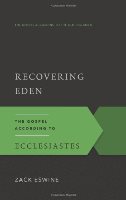Reviewed by Stephen Jenks
Ecclesiastes is notoriously difficult to interpret. Moving from the Old Testament to the gospel can be an equally daunting task. Put the two together and you have the challenge placed before Zack Eswine in writing Recovering Eden: The Gospel According to Ecclesiastes.
Approaching Ecclesiastes
Because of its challenging material and tone, unlike some other biblical books, Ecclesiastes has generated several distinct ways of understanding how it teaches. Which approach one embraces has significant impact on the final interpretation. One may decide that the book teaches as straightforwardly as other texts do and deny or explain away the challenging portions. One may acknowledge the dark tone and occasionally problematic statements (“Thus, I hated life.”), but conclude that this is merely part of the author’s strategy to shock the reader with realism in service of a final message that is thoroughly orthodox. Finally, one may determine that the dark tone and seemingly unorthodox material point toward an altogether different teaching strategy – one that perhaps includes highlighting the truth by showing what is false or only partially true and expecting the wise reader to discern the difference.
In two introductory chapters Eswine reckons with the challenging voice and method of the author of Ecclesiastes. He very briefly acknowledges issues of authorship and is content to accept Solomon as the author. Further, he positions himself quite clearly in the second of the approaches enumerated above. He presents the author as “focusing on exceptions” and speaking uncomfortable truths about the world. On his reading, the dark reality of the world (and book) is countered by brief moments of affirmation about God and the good life.
Here Eswine also reveals his rubric for moving from Ecclesiastes to the gospel: recovering Eden. He concludes that the fundamental message of Ecclesiastes is that “[t]he best good in the madness under the sun is found when we recover some small resemblance to what we were made for in Eden” (15). This conclusion relies heavily on the repeated refrain “There is nothing better than…” found at Eccl. 2:24-25; 3:12-13, 22. For Eswine, these verses represent the points of light in the dark canvas of the book.
From Preacher to Shepherd
After these introductory chapters Eswine moves in a semi-sequential way through the book. Main thought units in the book receive direct attention while parallel verses are culled from elsewhere in Ecclesiastes (and Proverbs) for support. He addresses the Preacher’s teaching on finding gain (“Meaningless!”), the role and limits of pleasure, the reality of death, knowing the times, the dangers of worship, and the pitfalls of leadership, among others.
Per the goals of the series, at the close of each of these chapters he attempts to make a bridge from his exposition to some aspect of the gospel, sometimes employing the idea of recovering Eden. In many chapters the links made are little more than comparisons of the Preacher’s teaching with Jesus’s. For instance, in the chapter “Knowing the Times” (3:1-8) he offers a list of references from the gospels revealing Jesus’s awareness of “appointed times.” In other places, he addresses how the gospel fills the emptiness that the Preacher exposes in the fallen world.
Evaluation
Probably the most perplexing question for me while reading this book was, “Who is the target audience?” The answer is shaped by several factors. First, Eswine’s audience is somewhat determined by his approach. The extent to which a reader finds the work helpful is directly proportional to the extent to which the reader accepts Eswine’s approach to the book. That said, even if one holds to the third approach, the negative interpretation, some of Eswine’s observations regarding how the Christ fulfills human longing are still apposite.
Serious students of Ecclesiastes will likely be disappointed with the level of Eswine’s engagement with the text and its context. Perhaps due to space constraints, Eswine very rarely “shows his work.” He often moves from the original context to the contemporary and from text to application without explicitly engaging the text and its context – textual or cultural. For instance, the Preacher’s warnings regarding careless worship (5:1-2) become immediately a discussion of how to engage with church. Accordingly, I do not foresee this being a fruitful read for a seminarian and only moderately helpful to a pastor preaching through Ecclesiastes.
Eswine’s writing style is casual and popular. The tone is often almost homiletical. He references popular music and movies, uses stories, and employs metaphors and analogies heavily. Each chapter closes with questions. These features suggest a popular audience is in view. But because Eswine’s treatment of the text is not comprehensive it is fair to ask whether he has offered to the reader sufficient framework and tools to engage the rest of the book. His concept of “recovering Eden” is a helpful idea. But I fear that the immediacy of his movement from text to application provides an insufficient guide and leaves many questions unanswered for the careful reader.
Efforts to move from the Old Testament to Christ should be encouraged, and Eswine’s work provides a few starting points for those interested in bridging that gap from Ecclesiastes. The connections between text and application are less developed than one might like for a book like Ecclesiastes, but Eswine’s exhortations are relevant and reveal a pastor’s concern. For that any reader should be grateful.
Stephen Jenks (PhD, Marquette) is pastor at Union Christian Church in Tegucigalpa, Honduras.
